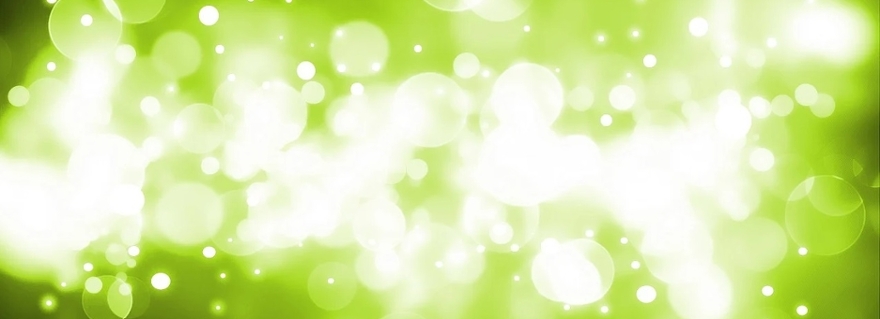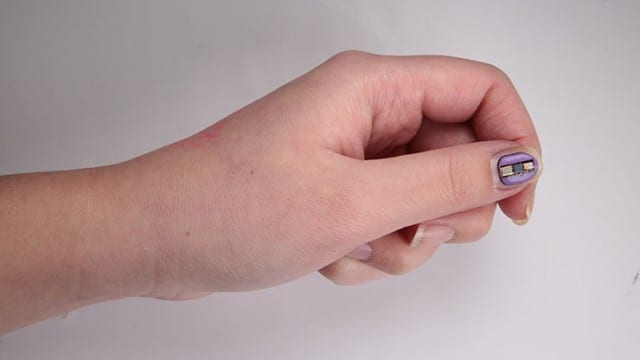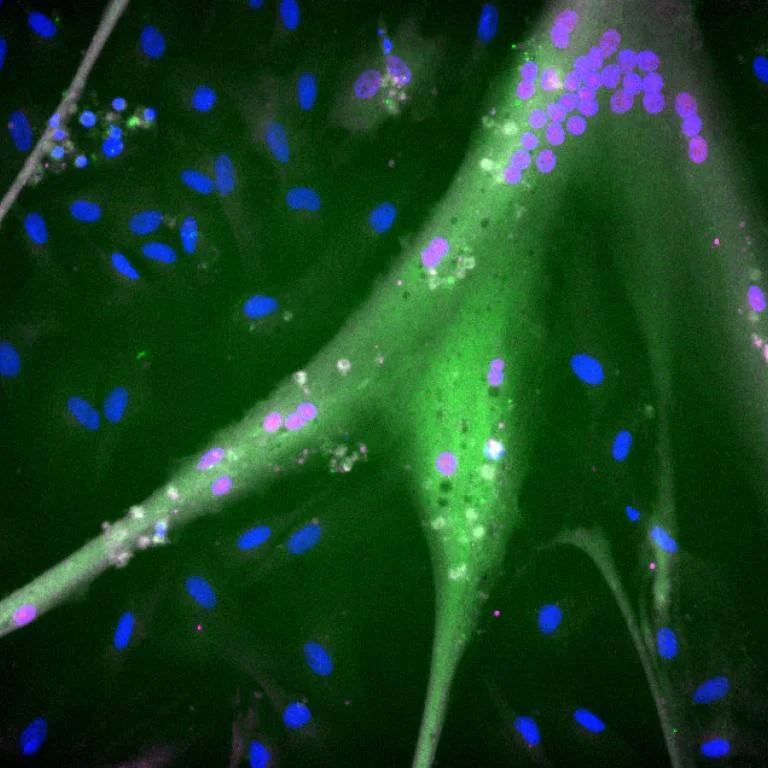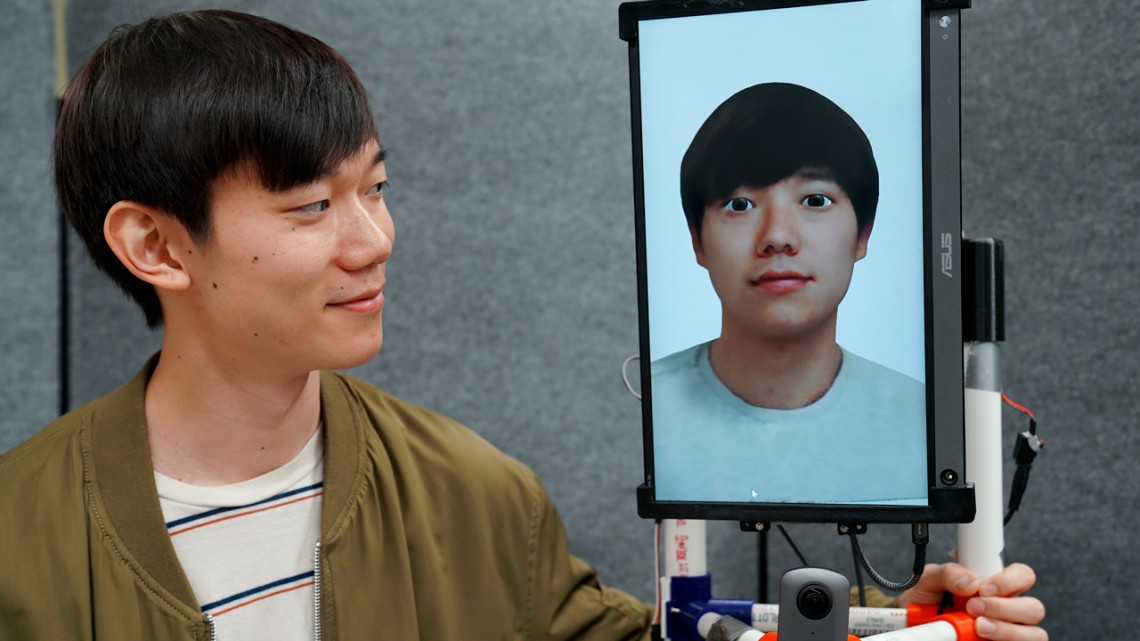
via Leiden University
Chemotherapy that does not harm the body, but effectively fights cancer cells: that is the goal of chemist Sylvestre Bonnet and his team.
During his PhD research, chemist Xuequan Zhou brought that goal a little closer. He developed molecules that, upon injection in the bloodstream, self-assemble into nanoparticles that accumulate in the tumour. Targeted irradiation with visible light then attacks the tumour thoroughly. The research has now been published in Nature Chemistry.
‘Conventional anti-cancer drugs often do not differentiate enough between good and bad cells,’ Bonnet explains. ‘They kill them both.’ The researchers have come up with a solution to this problem: nanoparticles that target the tumour and only become active under the influence of visible light. ‘This anticancer phototherapy allows doctors to treat a specific part of the body without damaging the rest. It is already in use in several hospitals.’
‘The lab work is no longer necesarry. You can administer these molecules directly.’
Molecules that form nanoparticles by themselves
Until now, chemists had to first attach the chemotherapy drugs to nanoparticles in the lab. Doctors then administered them by injection into the patient’s bloodstream. Conjugation to the nanoparticles helped the chemotherapy find the tumour. Zhou’s drug work slightly differently. ‘The lab work is no longer necessary,’ he says. ‘You can administer the molecules directly. Once in the blood, nanoparticles then form all by themselves.’
And that has several advantages, says Zhou. ‘First, it saves a lot of work and preparation time. But in addition, it is also safer and more effective.’ Making nanoparticles in the lab is complicated: it always creates a mix of particles with varied sizes and therefore different properties. It is difficult to precisely determine the composition of that mix. So you are never 100 per cent sure how these particles are going to behave in your body.
Zhou: ‘With a molecule, this is more straightforward: when you make molecules, chemical analysis allows you to determine whether they are pure.’ Bonnet: ‘If you then inject these molecules into the blood, the resulting nanoparticles are all really similar. That is because the body processes those molecules all in the same way.’
A drug that only works under visible light – How does that work?
Xuequan’s molecule is a so-called palladium complex: a molecule with a metallic core made of palladium. Normally, the palladium atom is connected to four nitrogen atoms, but Zhou replaced two of those nitrogen atoms with carbon atoms. When irradiated with green light, the palladium complex gains extra energy. That extra energy causes the complex to transfer electrons to the oxygen molecules (O2) already present in the irradiated cells. This mechanism creates a reactive oxygen species that kills cancer cells.
Another step towards effective therapy
Back in 2020, Zhou also made a cancer drug with self-assembling properties. ‘However, this new molecule is one step further,’ he says. ‘By binding not one but two carbon atoms to the metal (see box), the drug is now activated under green light, instead of blue.’ Green light allows better penetration into body tissue and is therefore much more useful for therapy in mice. ‘Our ultimate goal is a drug that works under infrared light,’ says Bonnet. ‘That light would allow even deeper penetration. It would allow us to fight larger tumours deep inside the body of human patients.’
Survival under complicated conditions
This new study followed a better, clinically more relevant approach. In the first study, Zhou and his colleagues injected the drug directly into the tumour. ‘This time we went a step further and looked in mouse models where the drug was injected into the bloodstream,’ he says. ‘After all, this is also how it would be done in hospitals. We wanted to know whether the drug nanoparticles would survive the conditions in the body. And fortunately, that was the case!’
‘10 out of 100 particles reach the final destination’
Zhou’s molecule proved to be very effective. ‘Ten per cent of the administered drug reaches the tumour,’ says Bonnet. ‘Out of every 100 molecules we administer, ten arrive at the destination. For many nanomedicines, that percentage is much lower. A study a few years ago showed that the average is only 0.7 per cent.’
‘We know it is effective. Further research shall unfold why.’
‘We don’t yet know exactly how it works either’
How exactly is this possible? Molecules that form nanoparticles by themselves? ‘We don’t exactly know that ourselves either,’ Bonnet admits. ‘We know palladium is critical , and Xuequan discovered that proteins in the blood probably play a role as well. If those proteins are missing, the nanoparticles keep growing and become so big that they eventually no longer stay in solution. It hence seems that the proteins limit the growth of the nanoparticles, but we cannot yet precisely tell how. We know it is effective. That’s the most important thing. But why it does work so well? That’s what further research will have to show.’
Original Article: Fighting cancer with light (and a drug that self-assembles into nanoparticles)
More from: Leiden University | Dalian University of Technology
The Latest Updates from Bing News
Go deeper with Bing News on:
Anticancer phototherapy
- Mycosis Fungoides
The dermatologist may order treatments such as topical steroids, phototherapy (PUVA or narrow-band UVB), nitrogen mustard, and BCNU (carmustine). A patient may be referred to a radiation ...
- Cancer News
May 7, 2024 — Using artificial intelligence, scientists have developed a powerful predictive model for identifying the most potent cancer killing immune cells for use in cancer ... Intermittent ...
- Solmed DUO Phototherapy Device from Meden-Inmed
The Solmed DUO Phototherapy Device Irradiation lamp with 2 radiators is intended for treatment by heating the skin tissue using the heat produced by the infrared light. The lamp can be used to ...
- Best Anti-Cancer Foods
While no single food is going to provide 100% protection from any type of cancer, research suggests that an anti-cancer foods list would lean heavily toward plant-based foods. Avoiding processed ...
- Anticancer drug development: the grand challenges
What are the key challenges in anticancer drug development, and how might they be addressed? The past three decades have seen spectacular advances in our understanding of the molecular and ...
Go deeper with Bing News on:
Self-assembling nanoparticles
- GIST Researchers Develop Nanotechnology for Creating Wafer-Scale Nanoparticle Monolayers in Seconds
The researchers engineered the electrostatic surface potential for both the target surface and the nanoparticles, driven by proton dynamics. This led the nanoparticles to get arrested onto the target ...
- Researchers develop nanotechnology for creating wafer-scale nanoparticle monolayers in seconds
Nanoscale materials present us with astonishing chemical and physical properties that help materialize applications such as single molecular sensing and minimally invasive photothermal therapy—which ...
- Arch Therapeutics to Present AC5® Advanced Wound System at the 2024 Symposium on Advanced Wound Care Spring Meeting (SAWC Spring)
A Study of AC5® Advanced Wound System in Patients with Lower Extremity Wounds to be Featured in a Clinical PosterFRAMINGHAM, Mass., May 06, 2024 (GLOBE NEWSWIRE) -- (OTCQB: ARTH) (“Arch” or the ...
- Vaccine Developers Leverage mRNA and Other Powerful Technologies
Axio developed OligoDOM, the VLP technology that Osivax uses to make its vaccines. Osivax describes it as a self-assembling nanoparticle platform that is designed to trigger T-cell and B-cell immune ...
- Form leading to function
But, just “how far can we push self-assembly 1?” This question is ... single chains collapsed individually to form nanoparticles as the UPy moieties formed multiple hydrogen-bonded ...










